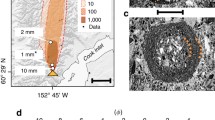To the memory of Professor Lev Grigor’evich Kachurin
Abstract
Analysis of the existing theories of hailstone growth has shown that there are two different approaches to the explanation of the layered structure of hailstones. L.G. Kachurin showed that the layered structure of ice on the surface of an object placed into the flux of supercooled water aerosol is controlled by the equilibrium film thickness. Another approach is based on the equation of heat balance at the hailstone surface and on the introduction of the critical water content. This paper elucidates the meaning of the critical equilibrium film thickness and establishes the relation between the two existing criteria controlling the transition from the dry regime of hailstone growth to the wet regime.
Similar content being viewed by others
References
M. K. Zhekamukhov, Some Problems of Formation of the Hailstone Structure (Gidrometeoizdat, Moscow, 1982) [in Russian].
R. G. Zakinyan, “To the Theory of Hailstone Growth,” Meteorol. Gidrol., No. 10, 59–67 (2000).
R. G. Zakinyan, “Theory of Forming a Layered Structure of a Spherical Hailstone,” Inzhen.-Fiz. Zh. 76(2), 42–47 (2003).
R. G. Zakinyan, “To the Theory of Forming a Layered Ice Structure on the Surface of a Plate Placed in a Flow of Supercooled Water Aerosol,” Zh. Tekhn. Fiz. 74(9), 9–14 (2004).
L. G. Kachurin, “To the Theory of Aircraft Icing,” Izv. Akad. Nauk SSSR, Ser. Geofiz., No. 6, 38–46 (1962).
L. G. Kachurin and V. G. Morachevskii, Kinetics of Phase Transitions of Water in the Atmosphere (Leningr. Gos. Univ., Leningrad, 1965) [in Russian].
B. J. Mason, The Physics of Clouds (Clarendon, Oxford, 1957; Gidrometeoizdat, Leningrad, 1961).
R. Rogers, A Short Course in Cloud Physics (Pergamon, New York, 1976; Gidrometeoizdat, Leningrad, 1979) [in Russian].
G. K. Sulakvelidze, Shower-Type Precipitation and Hail (Gidrometeoizdat, Leningrad, 1967) [in Russian].
A. N. Tikhonov and A. A. Samarskii, Equations of Mathematical Physics (Nauka, Moscow, 1977; Pergamon, Oxford, 1964).
V. G. Khorguani, Microphysics of Hailstone Nucleation and Growth (Gidrometeoizdat, Leningrad, 1984) [in Russian].
R. List, “The Physics of Supercooling of Thin Water Skins Covering Gyrating Hailstones,” J. Atmos. Sci. 47, 1919–1925 (1990).
R. List, “Hailstone Heat and Mass Transfer Theory and Three-Component Nusselt Numbers,” Atmos. Res. 32, 85–94 (1994).
F. H. Ludlam, “Hailstone Studies,” Nubila, No. 1, 28 (1958).
T. E. Schumann, “The Theory of Hailstone Formation,” Q. J. R. Meteorol. Soc. 94, 3 (1938).
Author information
Authors and Affiliations
Corresponding author
Additional information
Original Russian Text © R.G. Zakinyan, 2008, published in Izvestiya AN. Fizika Atmosfery i Okeana, 2008, Vol. 44, No. 2, pp. 221–226.
Rights and permissions
About this article
Cite this article
Zakinyan, R.G. On the theory of hailstone growth. Izv. Atmos. Ocean. Phys. 44, 207–212 (2008). https://doi.org/10.1134/S0001433808020084
Received:
Accepted:
Published:
Issue Date:
DOI: https://doi.org/10.1134/S0001433808020084




